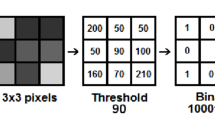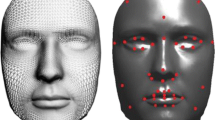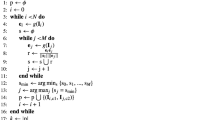Abstract
Facial expression synthesis is getting a wide-spread attention since past several years due to its multimedia applications. In most of the earlier research works, example images of target expressions are required to produce synthesized facial expressions. The paper aims to generate six basic and twelve blended facial expressions from a static and RGB neutral face image without any exemplar of expressive face images. The proposed automatic expression generation system consists of several sub-systems, namely, a knowledge-based system, a module for symbolic formulations of basic and blended facial expressions, an expressive facial components generator and an expressive face generator. The knowledge-based system stores the normalized facial feature parameter values. Symbolic formulations of facial expressions are used to reconstruct facial expressions from a static neutral face image using the parameters stored in the knowledge base. Expressive facial components generator performs automatic expressive facial feature generation as well as automatic facial feature extraction and landmark annotation. Finally, expressive facial components are combined to produce an expressive face in expressive face generator. The system generated expressive face images are validated in four different ways: inter-rater reliability measure, similarity measurement in the frequency domain, similarity measurement using SSIM, FSIM, HOG features and accuracy measurement using both appearance-based and geometry-based feature extraction methods. The geometry based feature extraction method generates 90% recognition accuracy for system generated face images.


















Similar content being viewed by others
References
Abboud B, Davoine F (2005) Bilinear factorization for facial expression analysis and synthesis. IEE-proc vision, image and. Signal Process 152(3):327–333
Adams R (1993) Radial decomposition of discs and spheres. CVGIP Graph Model Image Process 55(5):325–332. https://doi.org/10.1006/cgip.1993.1024
Agarwal S, Chatterjee M, Mukherjee DP (2012) Synthesis of emotional expressions specific to facial structure. Proc. 8th Indian Conf. Computer vision, graphics and image processing, 2012, https://doi.org/10.1145/2425333.2425361
Agarwala A (2007) Efficient gradient-domain compositing using Quadtrees. ACM Trans Graph. https://doi.org/10.1145/1276377.1276495
Bhattacharjee D, Halder S, Nasipuri M, Basu DK, Kundu M (2009) Construction of human faces from textual descriptions. Soft Comput 15:429–447. https://doi.org/10.1007/s00500-009-0524-z.
Bhowmik MK, Saha K, Saha P, Bhattacharjee D (2014) DeitY-TU face database: its design, multiple cameras capturing, characteristics, and evaluation. Opt Eng 53(10):102106–1–102106-24. https://doi.org/10.1117/1.OE.53.10.102106
Calvin M, Qi R, Raghavan V (2003) A linear time algorithm for computing exact Euclidean distance transforms of binary images in arbitrary dimensions. IEEE Trans Pattern Anal Mach Intell 25(2):265–270. https://doi.org/10.1109/TPAMI.2003.1177156
Chen Y, Lin W, Zhang C, Chen Z, Xu N, Xie J (2013) Intra-and-inter-constraint-based video enhancement based on piecewise tone mapping. IEEE Trans Circuits Syst Video Technol 23(1):74–82. https://doi.org/10.1109/TCSVT.2012.2203198
Contreras V (2005) Artnatomy/Artnatomia. Spain. http://www.artnatomia.net
Dalal N, Triggs B (2005) Histograms of oriented gradients for human detection. Proc. Computer Vision and Pattern Recognition, San Diego, pp 886–893
Daugman J (2004) How iris recognition works. IEEE Trans Circuits Syst Video Technol 14(1):21–30. https://doi.org/10.1109/TCSVT.2003.818350
Du S, Tao Y, Martinez AM (2014) Compound facial expressions of emotion. Proc Ntl Acad Sci USA 111:E1454–E1462. https://doi.org/10.1073/pnas.1322355111
Ekman P, Friesen WV (1978) Facial action coding system. Consulting Psychologist Press, Palo Alto
Fleiss JL (1971) Measuring nominal scale agreement among many raters. Psychol Bull 76(5):378–382. https://doi.org/10.1037/h0031619
Haralick RM, Shapiro L (1992) Computer and Robot Vision. Vol. 1, Addison-Wesley Publishing Company, Boston pp 174–185.
Huang D, Torre FD (2010) Bilinear kernel reduced rank regression for facial expression synthesis. In: Daniilidis K, Maragos P, Paragios N (eds), Lecture notes in computer science, Springer, https://doi.org/10.1007/978-3-642-15552-9_27
Johnson NL, Kotz SI, Balakrishnan N (1995) Continuous univariate distributions, 2nd edn. Wiley, New York
King I, Hou HT (1996) Radial basis network for facial expression synthesis. Proc. Int Conf Neural Info Processing
Kouzani AZ, Nahavandi S (2001) Constructing artificial images of facial expressions. Seventh Australian and New Zealand Intelligent Information Systems Conf, pp 18–21. https://doi.org/10.1109/ANZIIS.2001.974072
Lankton S (2009) Sparse Field Methods. Technical Report. Georgia institute of technology.
Li H, Weise T, Pauly M (2010) Example-based facial rigging. ACM Trans Graph 29(4):1–12. https://doi.org/10.1145/1778765.1778769
Li K, Dai Q, Wang R, Liu Y, Xu F, Wang J (2014) A data-driven approach for facial expression retargeting in video. IEEE Trans Multimedia 16(2):299–310. https://doi.org/10.1109/TMM.2013.2293064
Liu Z, Shan V, Zhang V (2001) Expressive expression mapping with ratio images. Proc. 28th annual Conf on computer graphics and interactive techniques, pp 271-276, https://doi.org/10.1145/383259.383289
Marrand D, Hildreth E (1980) Theory of edge detection. Proc R Soc Lond B Bio Sci 207(1167):187–217. https://doi.org/10.1098/rspb.1980.0020
Otsu N (1979) A threshold selection method from gray-level histograms. IEEE Trans Syst Man Cybern 9(1):62–66. https://doi.org/10.1109/TSMC.1979.4310076
Parker JR (1997) Algorithms for image processing and computer vision. Wiley, New York
Pratt WK (1991) Digital Image Processing. Wiley, New York
Saha P, Bhattacharjee D, De BK, Nasipuri M (2016) Mathematical representations of blended facial expressions towards facial expression modeling. Procedia Comput Sci 84:94–98. https://doi.org/10.1016/j.procs.2016.04.071
Sheu J-S, Hsieh T–S, Shou H–N (2014) Automatic generation of facial expression using triangular geometric deformation. J Appl Res Technol 12(6):1115–1130. https://doi.org/10.1016/S1665-6423(14)71671-2
Smith JO (2007) Mathematics of the discrete Fourier transform (DFT). 2nd edition, W3K publishing
Soille P (1999) Morphological image analysis: principles and applications. Springer-Verlag, Berlin Heidelberg
Song M, Dong Z, Theobalt C, Wang H, Liu Z, Seidel H (2007) Generic framework for efficient 2D and 3D facial expression analogy. IEEE Trans Multimedia 9(7):1384–1395. https://doi.org/10.1109/TMM.2007.906591
Susskind JM, Hinton GE, Movellan JR, Anderson AK (2008) Generating facial expressions with deep belief nets. In: Jimmy or (ed) affective computing, InTech, pp. 421–440, https://doi.org/10.5772/6167, 2008.
Tang X, Stewart WK (2000) Optical and sonar image classification: wavelet packet transform vs. Fourier transform. Comput Vis Image Underst 79(1):25–46. https://doi.org/10.1006/cviu.2000.0843
Thies J, Zollhofer M, NeiBner M, Valgaerts L, Stamminger M, Theobalt C (2015) Real-time expression transfer for facial reenactment. ACM Trans Graph 34(6):183:1–183:14. https://doi.org/10.1145/2816795.2818056
Tian YL, Kanade T, Cohn JF (2001) Recognizing action units for facial expression analysis. IEEE Trans Pattern Anal Mach Intell 23:97–115. https://doi.org/10.1109/34.908962
Tsai Y, Lin H J, Yang F W (2012) Facial expression synthesis based on imitation. In: Dornaika F (ed) International journal of advanced robotic systems, InTech, pp 1–6 https://doi.org/10.5772/51906
Viola P, Jones MJ (2001) Robust real time object detection. Int J Comp Vis 57(2):137–154. https://doi.org/10.1023/B:VISI.0000013087.49260.fb
Wan X, Jin X (2012) Data-driven facial expression synthesis via Laplacian deformation. Multimed Tools Appl 58:109–123. https://doi.org/10.1007/s11042-010-0688-7
Wang Z, Bovik AC, Sheikh HR, Simoncelli EP (2004) Image quality assessment: from error visibility to structural similarity. IEEE Trans IP 13(4):600–612
Wu J, Chi H, Chi L (2011) A cloud model-based approach for facial expression synthesis. J Multimed 6(2):217–224. https://doi.org/10.4304/jmm.6.2.217-224.
Xavier I, Pereira1 M, Giraldi G, Gibson S, Solomon C, Rueckert D, Gillies D, Thomaz C (2015) A photo-realistic generator of most expressive and discriminant changes in 2D face images. Proc Sixth Int Conf Emerging Security Technologies, pp 80–85. https://doi.org/10.1109/EST.2015.17
Xie W, Shen L, Yang M, Jiang J (2017, 2017) Facial expression synthesis with direction field preservation based mesh deformation and lighting fitting based wrinkle mapping. Multimed Tools Appl. https://doi.org/10.1007/s11042-017-4661-6
Xiong L, Zheng N, Du S, Wu L (2009) Extended facial expression synthesis using statistical appearance model. 4th IEEE Conf industrial electronics and applications, pp 1582-1587. https://doi.org/10.1109/ICIEA.2009.5138461
Yang C–K, Chiang W–T (2008) An interactive facial expression generation system. Multimed Tools Appl 40(1):41–60. https://doi.org/10.1007/s11042-007-0184-x
Zhang Y, Ji Q (2005) Active and dynamic information fusion for facial expression understanding from image sequences. IEEE Trans Pattern Anal Mach Intell 27(5):699–714. https://doi.org/10.1109/TPAMI.2005.93
Zhang Q, Liu Z, Guo B, Terzopoulos D, Shum H–Y (2006) Geometry-driven photorealistic facial expression synthesis. IEEE Trans Vis Comput Graph 12(1):48–60. https://doi.org/10.1109/TVCG.2006.9
Zhang L, Zhang D, Mou X (2011) FSIM: a feature similarity index for image quality assessment. IEEE Trans Image Process 20(8):2378–2386
Zhang Y, Lin W, Sheng B, Wu J, Li H, Zhang C (2012) Facial expression mapping based on elastic and muscle-distribution-based models. IEEE Int Symp Circuits Syst:2685–2688. https://doi.org/10.1109/ISCAS.2012.6271860
Zhang Y, Lin W, Zhou B, Chen Z, Sheng B, Wu J (2014) Facial expression cloning with elastic and muscle models. J Vis Commun Image Represent 25(5):916–927. https://doi.org/10.1016/j.jvcir.2014.02.010
Zhe X, John D, Boucouvalas AC (2004) Emotion extraction engine: expressive image generator. Proc HCI:367–381. https://doi.org/10.1007/978-1-4471-3754-2_23
Zhu X, Li X, Song L (2013) A 2D personalized facial expression generation approach. Proc. 2nd Int. Conf. Innovative computing and cloud computing, China, pp. 78–82, https://doi.org/10.1145/2556871.2556889
Acknowledgements
The work presented here is being conducted under the research project supported by the Grant No. 12(2)/2011-ESD, dated 29/03/2011, from DeitY, MCIT, Government of India. The first author is grateful to Department of Science and Technology (DST), Government of India for providing her Junior Research Fellowship-Professional (JRF-Professional) under DST-INSPIRE fellowship program (No. IF131067).
Author information
Authors and Affiliations
Corresponding author
Rights and permissions
About this article
Cite this article
Saha, P., Bhattacharjee, D., De, B.K. et al. Facial component-based blended facial expressions generation from static neutral face images. Multimed Tools Appl 77, 20177–20206 (2018). https://doi.org/10.1007/s11042-017-5436-9
Received:
Revised:
Accepted:
Published:
Issue Date:
DOI: https://doi.org/10.1007/s11042-017-5436-9




